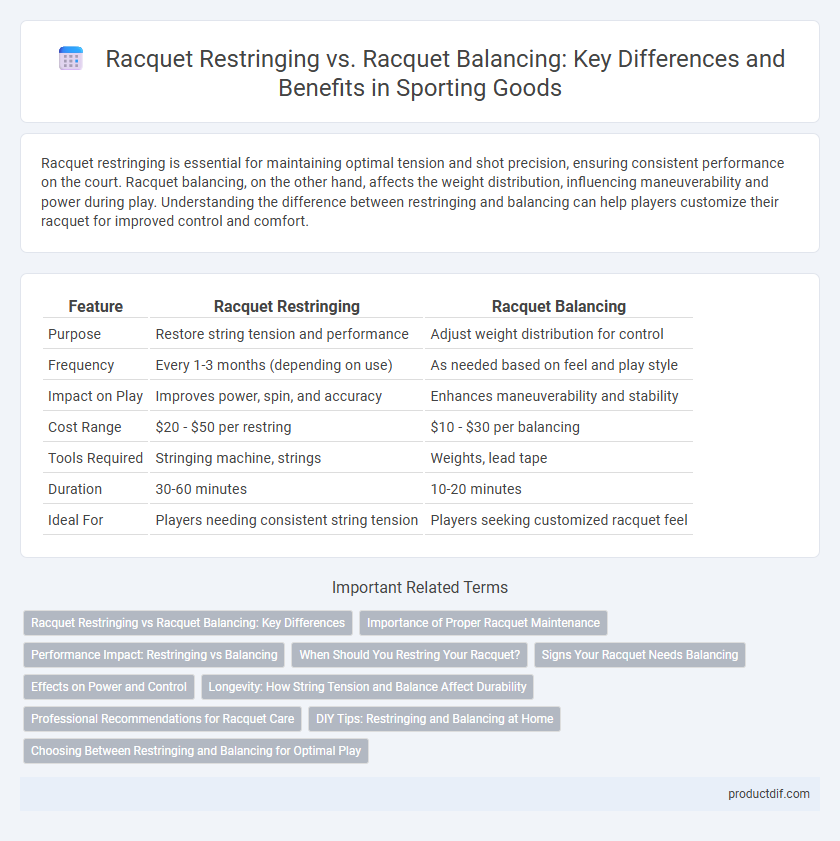Racquet restringing is essential for maintaining optimal tension and shot precision, ensuring consistent performance on the court. Racquet balancing, on the other hand, affects the weight distribution, influencing maneuverability and power during play. Understanding the difference between restringing and balancing can help players customize their racquet for improved control and comfort.
Table of Comparison
| Feature | Racquet Restringing | Racquet Balancing |
|---|---|---|
| Purpose | Restore string tension and performance | Adjust weight distribution for control |
| Frequency | Every 1-3 months (depending on use) | As needed based on feel and play style |
| Impact on Play | Improves power, spin, and accuracy | Enhances maneuverability and stability |
| Cost Range | $20 - $50 per restring | $10 - $30 per balancing |
| Tools Required | Stringing machine, strings | Weights, lead tape |
| Duration | 30-60 minutes | 10-20 minutes |
| Ideal For | Players needing consistent string tension | Players seeking customized racquet feel |
Racquet Restringing vs Racquet Balancing: Key Differences
Racquet restringing involves replacing worn or broken strings to restore optimal tension and playability, directly impacting ball control and power. Racquet balancing adjusts the weight distribution across the frame, influencing maneuverability and swing speed but does not affect string tension or string-bed response. Understanding these differences helps players enhance performance by targeting specific aspects of racquet setup for their playing style.
Importance of Proper Racquet Maintenance
Proper racquet maintenance, including restringing and balancing, significantly enhances performance and extends the lifespan of your equipment. Regular restringing maintains optimal string tension for better control and power, while precise racquet balancing improves maneuverability and shot accuracy. Investing in these maintenance practices prevents premature wear and ensures consistent playability on the court.
Performance Impact: Restringing vs Balancing
Racquet restringing directly affects ball control, spin, and power by restoring string tension and elasticity, which is crucial for precise shot execution. Racquet balancing influences maneuverability and swing speed, as adjusting the weight distribution can enhance stability or quickness depending on whether the balance point shifts toward the head or handle. Optimizing both restringing and balancing is essential for maximizing overall tennis performance by tailoring racquet response to individual playing styles.
When Should You Restring Your Racquet?
Racquet restringing is essential when strings show signs of fraying, lose tension, or after extensive play, typically every 20-40 hours on court for regular players. Maintaining proper string tension ensures optimal ball control, power, and injury prevention, making timely restringing crucial for competitive performance. While racquet balancing affects swing weight and maneuverability, restringing directly influences playability and shot precision, marking it as the priority for routine maintenance.
Signs Your Racquet Needs Balancing
Uneven shot accuracy, frequent mishits, and increased arm fatigue are key signs your racquet needs balancing. If your racquet feels heavy on the head or overly light in the handle, the weight distribution is likely off, affecting control and power. Proper racquet balancing enhances swing stability and shot precision, improving overall performance on the court.
Effects on Power and Control
Racquet restringing directly affects power and control by altering string tension; higher tension enhances control but reduces power, while lower tension increases power with less precision. Racquet balancing changes the distribution of weight, influencing maneuverability and shot stability; a head-heavy balance boosts power, whereas a head-light balance improves control. Players often adjust both restringing and balancing techniques to optimize their racquet's performance for specific playing styles.
Longevity: How String Tension and Balance Affect Durability
String tension critically influences racquet longevity by maintaining optimal elasticity and reducing premature wear; high tension can cause strings to break faster, while lower tension prolongs string life. Racquet balancing impacts durability by distributing stress more evenly across the frame, with head-heavy racquets experiencing greater strain on the strings compared to head-light models. Proper combination of string tension and racquet balance ensures enhanced performance and extends the lifespan of both strings and racquet frame.
Professional Recommendations for Racquet Care
Professional recommendations for racquet care emphasize racquet restringing every 20 to 40 hours of play to maintain optimal string tension and performance. Racquet balancing, which involves adjusting weight distribution, is suggested less frequently but is crucial for improving swing mechanics and control during competitive matches. Experts advise regular assessments by certified technicians to customize restringing and balancing according to individual play styles and racquet specifications.
DIY Tips: Restringing and Balancing at Home
DIY racquet restringing requires proper tools such as a stringing machine, tension calibrator, and quality strings to maintain optimal performance and durability. Balancing your racquet at home involves measuring the weight distribution using a balance board or simple scale tests to achieve a preferred head-heavy or head-light feel for better control and power. Regularly combining restringing and balancing enhances responsiveness and prolongs the lifespan of tennis and badminton racquets.
Choosing Between Restringing and Balancing for Optimal Play
Choosing between racquet restringing and racquet balancing depends on factors like string tension durability and racket weight distribution. Restringing restores string elasticity and power, crucial after significant wear or fraying to maintain control and spin. Balancing adjusts the racket's weight to optimize maneuverability and stability, enhancing shot accuracy and reducing player fatigue.
Racquet restringing vs Racquet balancing Infographic

 productdif.com
productdif.com